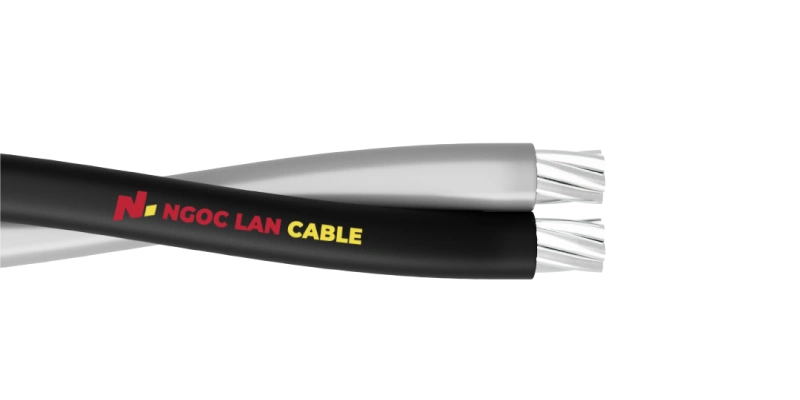Aluminum 7 strand cables represent an efficient and cost-effective electrical conductor solution. This article provides detailed insights into the cable's composition, classification, and critical selection factors to ensure you choose the most suitable cable for your specific electrical transmission needs.
1. What is an Aluminum 7 Strand Cable?
Aluminum 7 strand cables are electrical conductors composed of seven small aluminum (Al) strands twisted concentrically and encased in an external insulation layer (PVC or XLPE). These cables are widely used in electrical systems due to their lightweight nature, affordable pricing, and excellent electrical conductivity.
The term “aluminum 7 strand cable” isn't a standard industry designation. Depending on cross-section, insulation layer, manufacturing specifications, and application, these cables have various identifying codes. While referred to as “aluminum 7 strand cables”, you might encounter different marking codes such as AV, AX, AVV… or DuAV.
Each model has unique properties, and AV cable is one of the most popular for residential use. To understand the common features of these wires, let's first look at their basic structure.
2. Technical Structure and Characteristics
The aluminum 7 strand cable essentially consists of two primary layers, but classification can vary based on specific usage requirements.
2.1 Structural Composition
Conductor Core
The conductor core comprises seven aluminum strands twisted and braided concentrically:
- Material Composition:
- Typically pure aluminum (relatively malleable) or industrial aluminum alloy (harder), enhancing electrical conductivity and corrosion resistance
- Twisted configuration provides flexibility, facilitating easier bending and installation
Insulation Layer
Manufactured from XLPE or PVC materials:
- XLPE (Cross-Linked Polyethylene):
- High-temperature resistance up to 90°C
- Durable in harsh environments
- Special compound with low toxic smoke emission
- Excellent impact resistance
- Lifespan up to 40 years
- PVC (Polyvinyl Chloride):
- Temperature resistance up to 70°C
- More flexible and adaptable
- Easier to bend in confined installation areas
- Special compounds with localized flame-retardant properties
- Lower cost compared to XLPE
Optional Protective Outer Sheath
An additional protective layer that may or may not be present:
- Typically made from PVC
- Protects cable from physical impacts
- Provides water resistance
- Enhances overall cable safety and durability
2.2 Technical Specifications
As mentioned in the structural composition, cables with 7 aluminum strands typically have cross-sections ranging from 16-35mm², with some general characteristics:
- Voltage: 0.6/1kV (low voltage)
- Conductor operating temperature: <70ºC
- Applicable Standards (depending on insulation):
- IEC 60502-1/ TCVN 5935-1
- IEC 60228/ TCVN 6612
- AS/NZS 3560
- TCVN 6647
Each country and industry has different electrical cable manufacturing standards. In the Vietnamese market, TCVN (Vietnamese Standard) and IEC (International Standard) are most prevalent.
3. Classification of Aluminum 7 Strand Cables
Classification by Cross-Section
Cable cross-section represents the cross-sectional area of the conductor core, directly affecting electrical conductivity. Larger cross-sections mean higher electrical transmission capacity. Common cross-section types include:
- 16mm² (7×1.70mm²)
- 25mm² (7×2.14mm²)
- 35mm² (7×2.14mm²)
Classification by Core Number and Manufacturing Specifications
With PVC and XLPE material options, you'll typically encounter the following classification codes:
- Single-core aluminum cable with PVC insulation: AV 16, AV 25, AV 35
- Double-core aluminum cable with PVC insulation: DuAV 16, DuAV 25, DuAV 35
- Single-core aluminum cable with XLPE insulation: AX 16, AX 25, AX 35
- Low-voltage aerial bundled cable (2-4 cores) with XLPE insulation: LV-ABC 2×16, LV-ABC 3×25, LV-ABC 4×25, LV-ABC 3×6+1×25
- Single (or 3-core) aluminum cable with XLPE insulation and PVC sheath: AXV 25, AXV 3×10, AXV 3×16
Classification by Core Structure
The 7 aluminum strand core of Class 2 is twisted in two configurations:
- Concentric twist (circular strand cross-section)
- Compressed concentric twist (hexagonal strand cross-section)
Important Note: 7-strand aluminum cables typically have cross-sections <35mm², with cross-sections >50mm² preferring 19-strand configurations to enhance cable flexibility and bending capabilities.
4. Advantages and Disadvantages
While copper cables have traditionally been the primary choice in electrical engineering, budget considerations are crucial for large-scale projects.
Let's examine the advantages and disadvantages of 7-strand cables comparing aluminum and copper materials:
You might be concerned about aluminum electrical cables after reviewing this comparison?
This comparison only highlights disadvantages compared to copper. Specifically for aluminum 7-strand cables, the characteristics are quite impressive:
- Excellent oxidation resistance, durability in harsh environments lasting 10-20 years
- Good impact resistance due to XLPE/PVC coating
- Extremely cost-effective electrical transmission performance because:
- Copper is 3 times heavier per unit volume
- Copper material costs 3 times more than aluminum
Therefore, when considering cost-technical calculations, 7-strand aluminum cables remain an optimal choice, satisfying most residential and industrial applications.
5. Applications of 7-Strand Aluminum Cables in Practice
7-strand aluminum cables with relatively small cross-sections are widely used across various domains from residential to light industrial applications:
Residential Applications
Aluminum 7 strand cables are commonly used in electrical systems for:
- Lighting system power supply
- Electrical outlet installations
- Ceiling, floor, and wall embedded wiring
Industrial Applications
In factories and industrial facilities, these cables are utilized to:
- Transmit electrical power between workshops
- Power industrial electrical equipment
- Install electrical switches
Agricultural Applications
7-strand aluminum cables also serve agricultural purposes by:
- Providing electricity for irrigation systems
- Illuminating livestock facilities
6. How to Choose the Right 7-Strand Aluminum Cable
Recommendation: According to TCVN 6612:2007 (IEC 60228:2004), the minimum cross-section for 7-strand aluminum cables is 10mm² to ensure safe usage. In practice, investors might design cables with cross-sections <10mm². However, Ngoc Lan Cable recommends users select cross-sections according to standard specifications to achieve optimal safety.
When selecting 7-strand aluminum cables, consider the following key factors:
Determine Usage Requirements
- Clearly identify the purpose (residential, industrial, agricultural)
- Assess the electrical equipment's power requirements
Select Cable Cross-Section
- Consult cable cross-section reference tables
- Choose cables with appropriate load capacity
- Ensure safety and prevent overloading
Choose Insulation Type
- Select insulation suitable for installation environment
- Consider indoor, outdoor, or humid area requirements
Select Reputable Brands
- Choose 7-strand aluminum cables from trusted manufacturers
- Verify clear technical specifications on packaging
- Ensure product safety and durability
Practical Cross-Section Selection Example:
Critical Note: The table provides reference information only. Actual power capacity depends on transmission distance, environmental temperature, and cable quality.
Absolute Caution: Do not independently select electrical cables based solely on this information. Always consult professional electricians or specialized installation consultants to ensure safety and optimal performance.
7. Price List for 7-Strand Aluminum Cables
Price Reference Table for Various 7-Strand Aluminum Cables:
Note: Wholesale prices change continuously based on fluctuations in imported raw material costs. Contractor customers are kindly requested to contact the sales department directly to receive an accurate quotation.
8. Frequently Asked Questions
Are 7-Strand Aluminum Cables Safe?
- Yes, 7-strand aluminum cables are safe when:
- Manufactured according to industry standards
- Installed using proper technical procedures
- Used within specified operational parameters
Can 7-Strand Aluminum Cables Be Installed In-Wall?
- Yes, but with important considerations:
- Select cables with appropriate insulation coating
- Strictly adhere to electrical system installation regulations
- Ensure compliance with local building and electrical codes
What's the Safest Way to Connect 7-Strand Aluminum Cables?
- Recommended connection methods:
- Use specialized connection terminals (copper-aluminum connection lugs)
- Ensure solid connections
- Maximize oxidation resistance
- Consult professional electricians for complex installations
Are There Other Aluminum Cable Types Besides 7-Strand?
- Alternative aluminum cable configurations include:
- Single-strand cables (VA)
- Multi-strand configurations:
- 19-strand cables
- 37-strand cables
- 61-strand cables
Should 7-Strand Aluminum Cables Replace Copper Cables?
- Considerations for Cable Replacement:Copper Cable Advantages:
- Higher malleability
- Superior load-bearing capacity
- Ideal for confined installation areas
- Better maintenance accessibility
Aluminum Cable Advantages:
- Significantly lighter weight
- More cost-effective
- Suitable for large-scale installations
- Economical for projects prioritizing weight and cost
Recommendation: Choose based on specific project requirements:
- Prioritize copper for high-precision, compact electrical systems
- Consider aluminum for large-scale, budget-conscious projects with moderate electrical transmission needs
Each application requires careful evaluation of technical specifications, installation environment, and budget constraints.
9. Why Choose 7-Strand Aluminum Cables?
7-strand aluminum cables offer outstanding advantages suitable for both residential and industrial projects:
Cost-Effectiveness
- Pricing approximately 60-70% lower than copper cables of equivalent cross-section
- Optimizes investment budget
- Provides economical electrical transmission solution
Installation Flexibility
- 7-strand concentric twist structure ensures cable malleability
- Easy to bend during construction and installation processes
- Adapts to complex installation environments
Environmental Durability
- XLPE/PVC insulation resists moisture
- Excellent heat resistance
- Superior oxidation protection
- Suitable for outdoor and harsh environment installations
High Versatility
- Meets diverse electrical needs
- Supports applications from lighting systems to power outlets
- Transmits electrical power efficiently across 16-35mm² cross-sections
10. 7-Strand Aluminum Cables – Optimal Electrical System Solution
7-strand aluminum cables represent a cost-effective electrical transmission solution meeting residential and industrial power requirements. With advantages including lightweight design, easy installation, oxidation resistance, and excellent thermal performance, these cables are ideal for lighting systems, power outlets, and medium-capacity electrical transmission.
Critical Selection Considerations
When choosing cables, focus on:
- Cross-section specifications
- Usage environment
- Quality standard compliance
Despite higher electrical resistance compared to copper, 7-strand aluminum cables remain an optimal economic-technical choice when carefully calculated. To ensure maximum safety and performance, always:
- Consult professional electricians
- Evaluate specific project requirements
- Consider long-term installation implications
Final Recommendation: Carefully assess your specific electrical transmission needs, balancing technical performance with economic constraints. These cables offer an intelligent solution for diverse electrical infrastructure challenges.

 VN
VN



